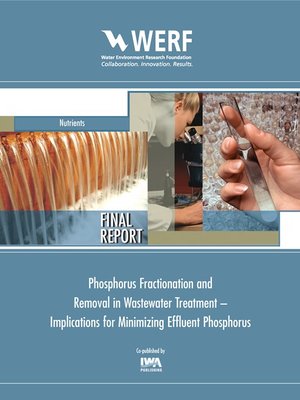Phosphorus Fractionation and Removal in Wastewater Treatment
ebook ∣ Implications for Minimizing Effluent Phosphorus · WERF Research Report
By April Z. Gu

Sign up to save your library
With an OverDrive account, you can save your favorite libraries for at-a-glance information about availability. Find out more about OverDrive accounts.
Find this title in Libby, the library reading app by OverDrive.



Search for a digital library with this title
Title found at these libraries:
| Library Name | Distance |
|---|---|
| Loading... |
To address increasing water quality problems associated with eutrophication, state environmental agencies and the United States Environmental Protection Agency (EPA) are requiring more stringent WWTP effluent total phosphorus concentrations that are below 0.10 mg/L and more recently values as low as 0.01 to 0.06 mg/L have been considered. These represent a large decrease in effluent phosphorus permit concentration, which has challenged the POTWs to investigate and evaluate treatment alternatives to achieve additional phosphorus removal by tertiary treatment and to determine the most minimum concentrations possible.
Previous studies indicated that as more advanced tertiary treatment processes are applied to eliminate nearly all the soluble reactive P in order to meet the extremely low TP limits, other non-reactive phosphorus species – such as organic P and acid-hydrolysable P – become a larger fraction of the effluent P and their behavior under different treatment methods needs to be understood. The fractional composition of effluent phosphorus and its variations between different WWTP processes have previously received little attention. Therefore, an urgent need exists to gain further fundamental understanding of effluent P chemical species in order to interpret and improve technologies for phosphorus removal to very low limits.
The objective of this study is to conduct a survey of P fractions and their fate and susceptibility to a range of different P removal processes, especially tertiary P removal processes. This will help us gain insights into the removal efficiency and mechanism of different P fractions through various treatment technologies.
Previous studies indicated that as more advanced tertiary treatment processes are applied to eliminate nearly all the soluble reactive P in order to meet the extremely low TP limits, other non-reactive phosphorus species – such as organic P and acid-hydrolysable P – become a larger fraction of the effluent P and their behavior under different treatment methods needs to be understood. The fractional composition of effluent phosphorus and its variations between different WWTP processes have previously received little attention. Therefore, an urgent need exists to gain further fundamental understanding of effluent P chemical species in order to interpret and improve technologies for phosphorus removal to very low limits.
The objective of this study is to conduct a survey of P fractions and their fate and susceptibility to a range of different P removal processes, especially tertiary P removal processes. This will help us gain insights into the removal efficiency and mechanism of different P fractions through various treatment technologies.







